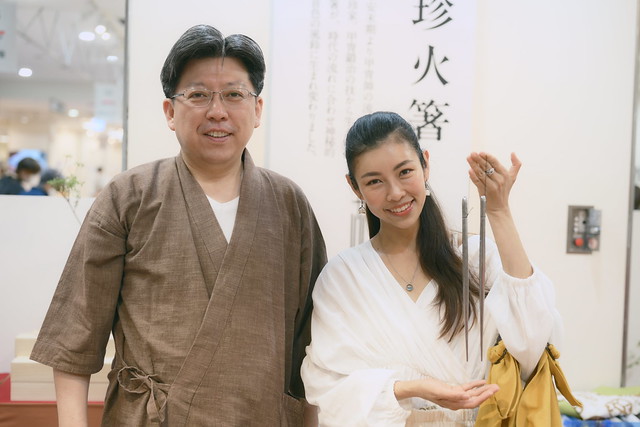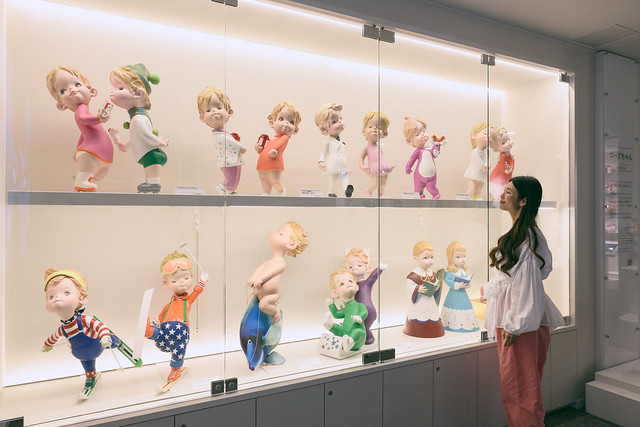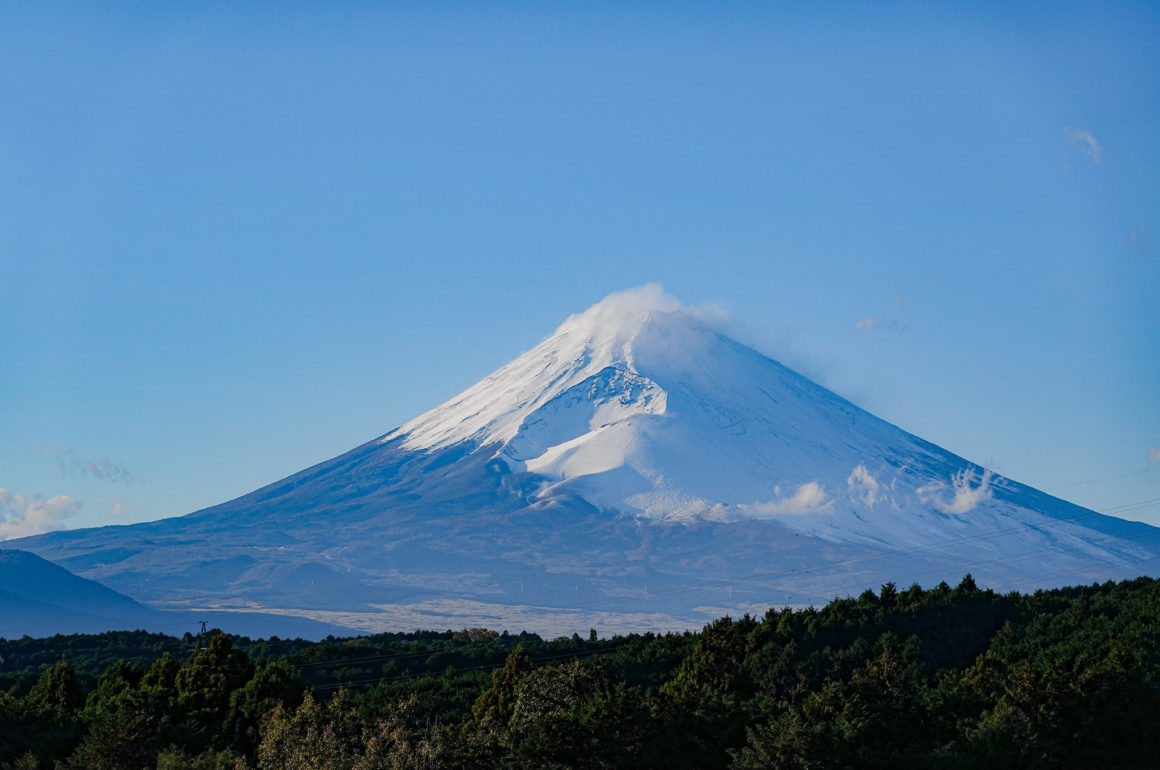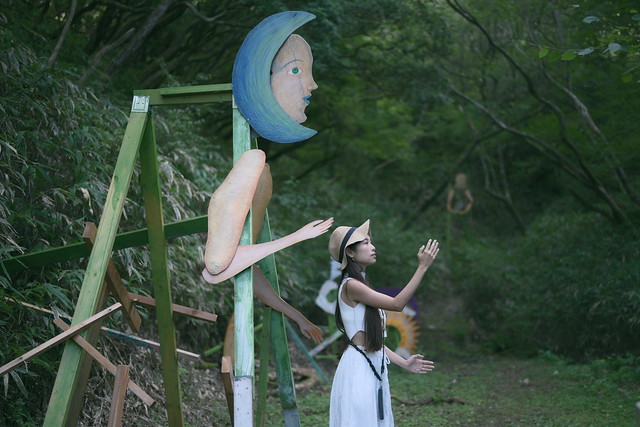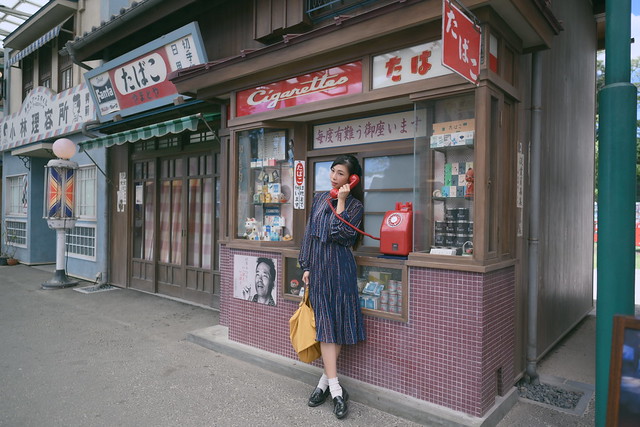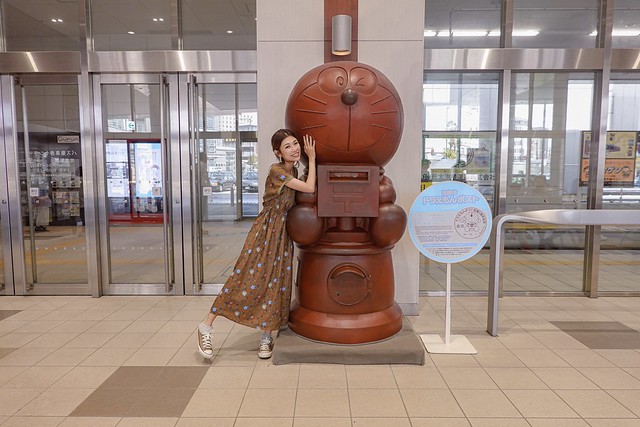
It’s Japan time again!
This time around I wanna bring you guys to Toyama, Nagano and Gifu area, on a self-drive trip.
We will be exploring these 3 prefectures by first flying into Toyama airport, rent a car and drive through the destinations. It will be a 5D4N trip of wonderful nature and rich culture in central Japan.
We are starting the trip with a flight to Toyama airport from Haneda via ANA!
Toyama Airport (All Nippon Airlines)

ANA flies to Toyama daily from Haneda, and it takes only an hour for you to get from Toyama from Tokyo.
My initial plan was to fly to Toyama from Changi airport via Haneda but there was some trouble as Haneda airport was overcrowded with planes which got stuck due to Kanto region’s typhoon on that particular day. It was my first international flight with ANA and I must say that despite unforeseen circumstances that happened due to natural causes, ANA’s in-flight crew and ground crew responded to our worries with utmost thoughtfulness that I was incredibly touched and impressed.
I posted a couple of stories on my IG about how grateful I was to ANA’s prompt actions in handling troubled times like this, and many, many followers sent me messages that they too, had really great experience with ANA. It really gave us all a lot of confidence flying with ANA!
You can check the flight prices here: https://www.ana.co.jp/en/sg/
Central Nippon Expressway Pass (CEP)
So after arriving at Toyama airport, we will need a car. Self-driving tours are gaining popularities as it gives us so much more freedom to travel at ease and our own pace without having to rush or keep time to catch the public transport.
As you may know, Japanese expressway charges are quite expensive. This is one of the unexpected cost incurred when you plan to self drive.
So, just as how foreign travellers enjoy railway passes benefits, you can actually also take advantage of your status as a foreign visitor to save travel expenses on self-driving!
Have you heard of CEP? It is a pass that lets you drive in central Japan area at a reasonable and fixed price, with the ETC (electronic toll collection system) card provided by desginated car rental companies, you can use the expressways without having to stop at toll plazas, helping to smoothen your journey, while helping you to save lots along the way.
There are 6 rental car companies (with over 177 rental car stores) which provide CEP service in Japan, so please look for:
Toyota Rent a Car
Times Car Rental
Nippon Rent-A-Car
ORIX Rent-A-Car
Nissan Rent-A-Car
Budget Rent a Car
Self-drive using CEP is also a great choice when you are traveling in group to save cost, compared to having to purchase railway passes for each individual. So it’s a perfect choice for family vacation.
You can find out more information over at CEP’s website: https://hayatabi.c-nexco.co.jp/cep/en/
And CEP’s Facebook Page: https://www.facebook.com/hayatabi.en
So here’s an itinerary of recommended spot you may like to take note for your trip covering Toyama, Nagano & Gifu.
TOYAMA
Day 1 Gokayama
Tokyo Haneda – Toyama Airport (NH315 ANA)
Taking the free shuttle from Toyama airport to Toyota Rental to pick up your vehicle with CEP
Self drive – Gokoyama (五箇山)
Accommodation: Yomoshirou (与茂四郎)
Gokayama Gassho Village
This is actually my second time to world heritage site, Gokayama Gassho Village. The first time I visited was 2018 winter. You may read the full blog post here.

I was surprised at how incredibly different it looks in summer time.

In winter, it is blanketed by fluffly white snow but comes summer time, it’s all lush in crisp, fresh air.

A typical gassho-zukuri residence. Up until today it’s still inhabited by the locals.

The first time I came here just to visit, but this time around I actually put a night up at one of the guest-houses, “Yomoshirou” and i must say that it was a very unique experience!

A very traditional, old wooden house but kept sparkly clean by the host.

The host of Yomoshirou, a super kind and friendly gentleman who takes great care of his guests. He can speak a little English, but you will have no problem understanding him with his rich expressions and big smiles, which is enough to brighten anyone’s day. He will accompany you during dinner and tell you stories and even perform a little!

Dinner was prepared by the wife served in a little standing tray, which is how the Japanese people dined before dining tables were introduced.

Although simple, it has truly captured the essences of the nature’s abundance of Gokayama. There was carp sashimi, grilled Iwana (a really delicious river fish), pickles, mountain vegetables and vegetable tempura. Truly wholesome and nutritionally balanced!

This was my room, typical futon on the tatami mat. You are basically staying over at their house so you will have to share the bathroom and toilet with the rest of the family. But their kind hospitality made me feel right at home!

Really lovely and happy host family. You can read up their reviews online, so far I only see tons of good comments about them! ^^
Day 2 Takaoka City 高岡市, Toyama City 富山市
Gokayama Washi-no-sato 五箇山和紙の里
Doraemon Tram Takaokacity
Nousaku 能作
Amaharashi 雨晴海岸
Dinner: Fukuya (冨久屋)
Accommodation: ANA Crowne Plaza Hotel
Gokayama Washi Making
Another experience you may want to check out is washi making experience. I have also covered this in my previous post about Gokayama, so I’ll go quick on this one!

This is Gokayama Washi No Sato, a place where you can join a very simple washi-makign workshop for just JPY700!
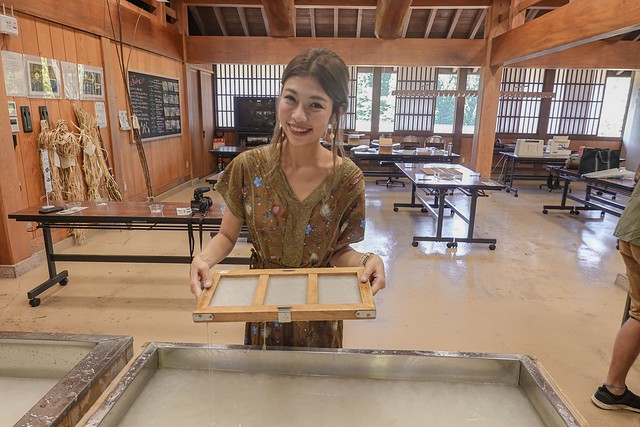
Doing it the second time, it feels really easy-peasy ^^

You will pick your choice of motifs to decorate the washi.

When it is freshly made, it is this thick!

They will then help heat-dry it and you can bring your very own hand-made washi postcards back home with you.
Takaoka City
Amaharashi

Come by Amaharashi for a scenic stop with the majestic view of Tateyama mountain range in sight, and Noto peninsula (Ishikawa pref.) on the other side.
The Toyama Bay is also a huge natural fish tank, a home of some of the most precious treasures from the sea of Japan such as Kanburi – winter yellow tail and of course Toyama’s prized catch, shiroebi.
Doraemon Tram

Did you know that the authors of Doraemon, Fujiko Fujio’s hometown is Toyama prefecture? To pay homage to one of the greatest manga ever made in history there’s a Doraemon tram running from Takaoka station to Koshinokata Station.

Also, at Takaoka station there’s a real Doraemon post box you can drop your letters into!
Remember to check this place out to rekindle that childhood nostalgia!
Nousaku

Established over 100 years ago, Nousaku is an extremely stylish craft center located in Takaoka city, Toyama.

The city of Takaoka has been at the heart of Toyama’s crafts for 400 years as the producer of over 90% of the nation’s bronze and a whole host of other metalworks.

Nousaku’s speciality is tin-making, and you will see an array of fashionable accessories and interior decor for your home. This tin-holder is now trending in Japan, being extremely versatile as it is flexible so you can bend it into customizing your own wine holder, fruit basket, etc.

There are also the shapes of all 47 prefectures. Please don’t let me start this collection. Haha.
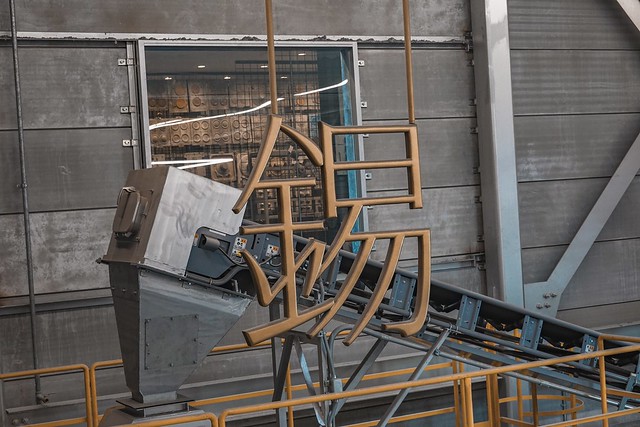
You know what else I love? Their open-concept factory.

Anyone can tour the factory to see how the actual work is done. I was shocked by how casual it was as not many companies open up to letting visitors witness the whole manufacturing work.

Here you learn about true Japanese artisan’s craftmanship, how most of the products made still require the precision of sharp eyes, dexterities of one’s arms and unrivalled concentration.

I love shokunin (craftsman). So much respect.

Also, there’s a space called the Nousaku Lab where you can make your very own tin accessory using the traditional sand casting method. We are making a simple paper-weight today!
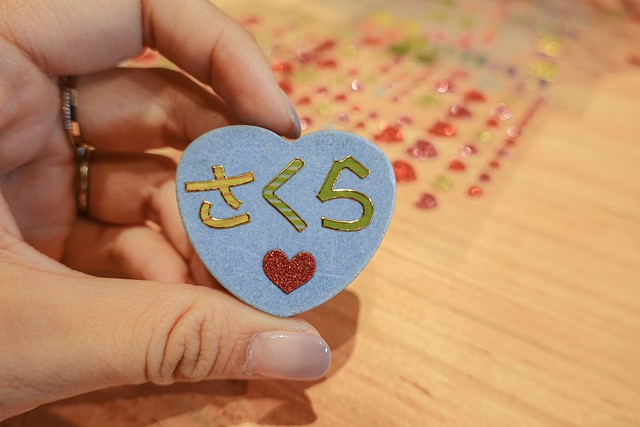
You will pick a mould and decorate it.

After that, you will make a sand cast out of it before pouring melted tin at extremely high temperature, let it cool down to produce a solid tin paper-weight with your original design.

Here’s mine!
Toyama City
Dinner: Fukuya
What you don’t wanna miss is fresh seafood in Toyama prefecture. You may have known its specialty – shiroebi (white shrimp), and Fukuya, a Michelin One-Star restaurant is a great place to splurge on!
Located at a pretty secluded backstreet of downtown Toyama, you may have some trouble finding it but even if your GPS doesn’t work, the friendly local will be happy to point you there!

I’m just going to spam some photos of the meal. We started luxuriously, with abalone simmered in beautifully flavored dashi.

This was absolutely amazing, shiroabi wrapped in homemade karasumi – salted mullet roe, a really luxurious delicacy that goes super well with Japanese sake (yummmm), so make sure you order one to go with it.

We often eat unagi grilled but this is served in a broth, cooked really soft! Super delicious.

Mini ikura bowl is Fukuya’s specialty. Unlike other ikura which tend to over too salty, it has just the right balance, making it an unforgettable dish in the course.

What is more amazing, we were served grilled ayu (sweet fish), and usually for foreigners some find it challenging to eat the whole fish so the chef actually separated the bones, fish head and tail and deep fried them into a delicious crispy snack. 10 points for thoughtfullness!

Finally, please keep some stomach space for the rice in a pot topped generously with karasumi bits. So, so yummy.
The course meal ranges from JPY6000 to JPY15,000. I think ours are priced at JPY10,000. Worth all the money if I may say!
Tateyama Kurobe Alpine Route
Day 3 Toyama prefecture – Nagano prefecture via Tateyama Kurobe Alpine Route
Toyama
8:30 Arrive at Tateyama Station
8:40-8:47 Tateyama-Bijodaira Cable Car (立山~美女平)
9:00-9:50 Bijodaira-Murodo Bus (美女平~室堂)
11:15-11:25 Murodo-Daikanbo (室堂~大観峰)
11:50-11:57 Daikanbo-Kurobedaira (Tateyama Ropeway) (大観峰~黒部平)
12:00-13:10 Restaurant Kurobedaira
13:20-13:25 Kurobedaira- Kurobe Dam (黒部平~黒部湖)
15:05-15:21 Kurobe Dam- Ogizawa by kanden tunnel electric bus (黒部ダム~扇沢)
Starting Point: Tateyama Station
Some of you might have heard of the Tateyama Alpine Route, starting from Toyama prefecture crossing the border to Nagano prefecture – one of the most popular attractions in central Japan.
I would suggest you to prepare to spend a whole day for this activity, as the journey across the route is quite an impressive attraction itself.
The Tateyama Kurobe Alpine Route boasts of 6 Number Ones in Japan –
1. Kurobe Dam- Ogizawa kanden tunnel electric bus is the only electric bus in Japan
2. Murudo station – the highest train station in Japan
3. Tateyama Ropeway – the longest unsupported ropeway in Japam
4. Shomyo Falls – the highest waterfall in Japan (350m)
5. Kurobe Dam – the tallest dam in Japan
6. Mikuriga-ike Hot Spring – Highest hotspring in Japan

You will start at Tateyama station and take the ropeway to Bijodaira, and a 50 minute long bus ride to Murodo.

From a far I witness the tallest waterfall of Japan – Shomyo Falls.

It was unfortunate that the whole way was rainy with heavy fog on the day I visited, but if you are blessed with good weather, this sight behind me at the Mikurigaike is supposed to take your breath away. You can google Tateyama Kurobe Alpine Route for all the instagenic inspirations.

It was white-out the entire time when I was there, but as I approached the lake, the weather suddenly cleared up for about 10 seconds just enough for me to snap some photos on frantic burst mode and here’s a photo that’s at least presentable.

The alpine is known for its crystal clear spring water. Many of the bottled water in Japan is actually sourced here at the alpines. You can take a short hike to the onsen and enjoy a soak even if you don’t stay over.
Kurobe Dam
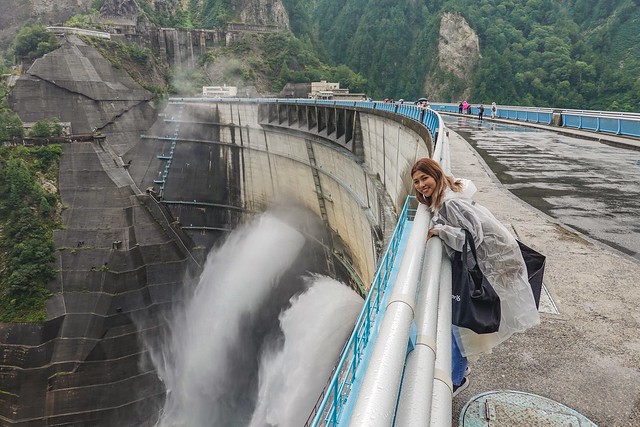
In the sudden economic boom following WW2, Japan faced a severe energy shortage, and this dam was build to generate electricity that supplies to the Kansai area so it is a really significant project at that point of time.

Try the chiffon cake that resembles the dam at the cafe at Kurobe for a sweet treat before continuing the journey.

For lunch, I recommend the Alpine Otani snow curry with Toyama shiroebi tempura at Kurobedaira station. Loved it. For muslim travelers, there are even halal selection too!

There’s also a Kurobe Dam version of green curry rice available at the observation deck.
When you self-drive, it is possible to have your car sent over to your destination (together with your luggages in the car, so there’s no additional charge!), while you enjoy the different rides including cable car, ropeway and electric bus. You can pick up your vehicle once you arrive at Ogizawa, Nagano prefecture and drive to your next destination.
Matsumoto City (Nagano Prefecture)
Day 3 (continued) – Matsumoto
Matcha Garden
Agetsuchi Theatre – Wadaiko (Japanese drum), Ninja & Samurai Workshop

Matcha Garden is a stylish little tea house in Matsumoto city where you can take a break and sip on a bowl of hot matcha or even learn how to make your very own Japanese green tea.

You probably have seen or even experienced a tea ceremony by now, what I like about Matcha Garden is that the atmosphere is rather casual with very friendly tea master and English-speaking staff so you don’t feel the nervousness compared to doing it in a traditional tea house.

Made my very own bowl of matcha!

This is Eina who speaks really good English, and the funny thing? Her best friend lives in Malaysia and it turned out that it’s actually a mutual friend of ours! What a small small world.
Also? There’s kimono experience too if you would like to dress yourself up in one!
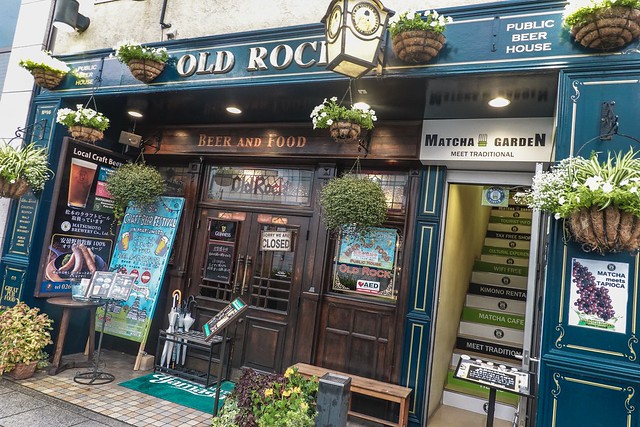
This is the entrance to Matcha Garden, next to it is a locally popular pub for some night time fun.

Pub-hopping is actually a big thing in Matsumoto so why not embrace the local culture and relax yourself ordering a local beer!

Also not forgetting the yummy beer snacks.
Taiko, Ninja and Samurai experience at Agetsuchi Theatre (上土劇場)
This was an impromptu itinerary and when I was told that we were going to watch taiko performance, I nearly jumped!
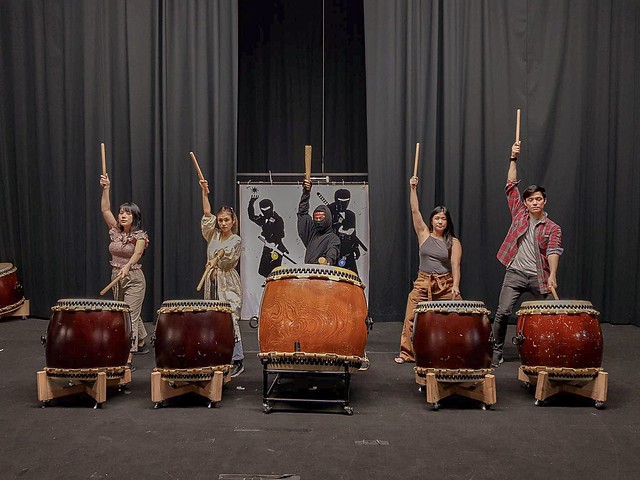
It was a short taiko experience but I had so much fun as you know I really love taiko.

You also get to enjoy a stunning ninja and samurai show too.
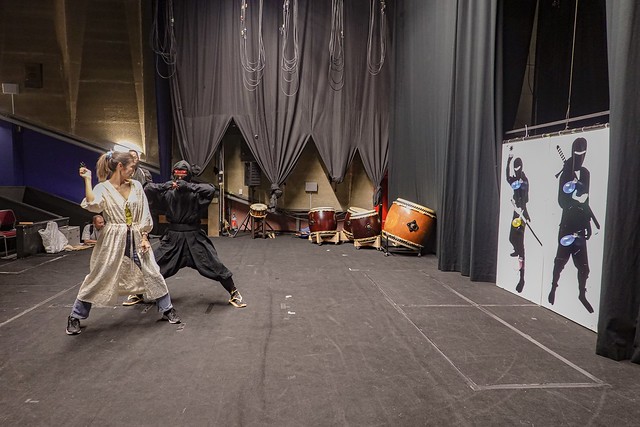
Other than watching the performances, here’s a chance to learn a few cool tricks of the ninja, see how good you are throwing shuriken to burst the balloons, as well as a few samurai stances with swords.
Kamikochi (Nagano Prefecture)
Day 4 Kamikochi 上高地
Matsumoto Castle 松本城
Lunch: Kamikochi Lemeiesta Hotel
Kamikochi National Park 上高地
Accommodation: Gero Onsen Suimeikan 下呂温泉:水明館
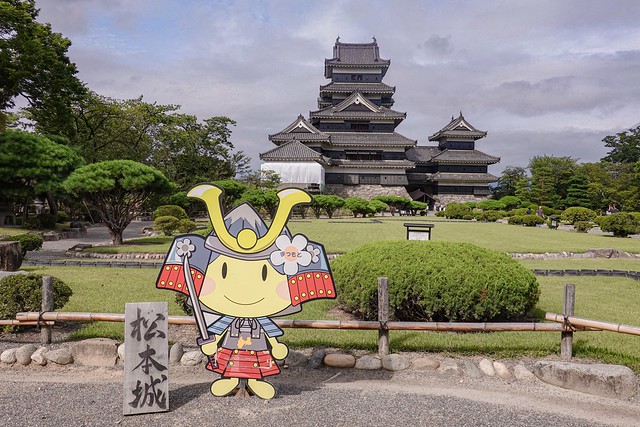
Matsumoto is actually the starting point of my Japan adventure. It’s hard to believe but out of hundreds of cities in Japan, Matsumoto was the first ever city I have ever visited in Japan.
I came to Japan 11 years ago for home stay for the first time in my life to meet my amazing host in Matsumoto, and the experience fueled my interest to explore Japan which later turned into a burning obsession gone beyond the point of no return haha.

This is Matsumoto castle, a castle considered as one of the most beautiful and complete designated as the National Treasure of japan. I don’t remember seeing samurai and princesses 11 years ago but it is sure nice to meet them!
Kamikochi

I think I have just found my new favorite healing spot. Upon entering the grounds of Kamikochi, a highland resort and part of Chubu Sangaku Nation Park, my usual sinus was gone. My lungs felt like an old, broken aircon finally being drastically serviced to mint condition. I breathed and breathed and breathed.
Back home (Malaysia and Singapore), everyone was troubled with assorted issues related to the serious haze happening this year, and how I wish I could take away all this fresh, clean air into bags and send them back to my family, friends, and everyone who is struggling to battle haze.
The whole parks exudes an array of scents. Was it the seasonal flowers? Mountain greens? Wild fern? I don’t know but it has such a special, refreshing scent that someone should produce a fragrance called “Kamikochi”.
And would you just look at the azure waters? It is part of the longest river in Japan – Shinano River , and flows into the Sea of Japan.

One thing to note – this national park is strictly protected and in an effort to reduce vehicle emissions, the area can only be accessed by licensed shuttle bus or taxi. You may park your rental car in a car park nearby and enter the park by public means.

Also, please be mindful as the park has strict rules on no littering. You are not allowed to leave anything behind or pick anything up with you here.
Lunch – Lemeiesta Hotel

We had beef curry at Lemeiesta Hotel and it was one of the most luxuriously delicious curry I’ve had!
The beef was so so tender and the tomato-based curry has just enough punch to keep your appetite going.

Check out also cute desserts made after the famous bridge in Kamikochi – Kappabashi (literally the ogre bridge).
Learn more about Kamikochi here: http://www.kamikochi.org/
Gero Onsen
Always ranked as one of the top and best hot spring in Japan, this is actually my second time there!
We are staying at Suimeikan for the night, and I have actually written a blog post about it already last year, please refer to that blog post for more info 🙂

This year they put me up in the newly renovated western style room, which, WHICH – has its own onsen bathtub!!
Also for tatami lovers, you can also requested for your futon (I did!) on the tatami instead of sleeping on the bed. ^^

Since we are in Gifu, you are not to miss out on the recently internationally famed Hida beef!

Hida beef steak, medium rare.
More info on Suimeikan and Gero Onsen in my blog post here: http://cheeserland.com/2018/04/gifu-gero-onsen/
Day 5 Gero & Seki City
Gero Onsen Gassho Mura 下呂温泉合掌村
Tsumago-juku 妻籠宿 & Magome-juku 馬籠宿
Seki Traditional Swordsmith Museum 関鍛冶伝承館
Toyama Airport – Haneda (NH322 by ANA)
Gero Onsen Gassho Mura

Other than Shirakawago and Gokayama, here’s another place you can get to see an authentic gassho-zukiri style houses. However they are not inhabited by the locals like the other two villages, but you can find 10 houses that forms an outdoor museum which recreates a mountain settlement from former times and offer a glimpse into what life might have been like for its inhabitants.

In spring time, this place is also surrounded by beautiful cherry blossom, making it a super instagenic spot.
Tsumago-juku & Magome-juku
Ok, mini history lecture time by Cheesie.
In the Edo period, there are two routes that connected Tokyo to Kyoto, the two most important cities in Japan.
One of them is the Todaiko 東海道 – literally “Eastern Sea Route” – that goes along the coastal region along the pacific ocean, crossing Kanagawa, Shizuoka, Aichi, Mie, Shiga, and finally, Kyoto. (I have briefly mentioned about one of the 53 stations – Shichiri No Watashi in my Mie blog post).
Another important route is called Nakasendo 中山道 – literally “Central Mountain Route” – that goes inland. There are 69 stations along this route crossing Saitama, Gunma, Nagano, Gifu, Shiga, and finally, Kyoto.
Tsumago is the 42nd and Magome the 43rd station of Nakasendo. Interestingly, even these two towns are pretty nearby each other, they are from different prefectures. Tsumago is located in Nagano Prefecture, and Magome sits on the border of Gifu prefecture.
Tsumago-Juku

These two towns are some of the most completely preserved historical post town in Japan and made great filming locations for Japanese dramas and movies.

The local putting up seasonal decoration and at the point of time it was for the mid autumn festival.
These traditional houses used to be inns and rest house for the daimyo and their families and samurais. You will see different ranks of “hotels” for the old time travelers and since they travelled by horses, you will also see rest houses for their trusty stallions.
Magome-juku

While Tsumago is extremely well preserved and feel incredibly authentic with original houses from 250 years ago since it was lucky enough to escape most of the fire incidents in old times, Magome is slightly more touristy, but also very beautifully restored.

You will find lots of quaint restaurants, souvenir shops and museums to spend your time at.
Seki Traditional Swordsmith Museum

Seki city in Gifu is known to produce some of the best blades in Japan – actually, in the world. I have visited another swordsmith place called Hamonoya Cutler Sanshu, and you can read all about it in this blog post: http://cheeserland.com/2018/03/gifu-seki-swordsmith/

There are lots of precious katana swords on display and this one really caught my eye. Can you see the tiny patterns carved into the blade?
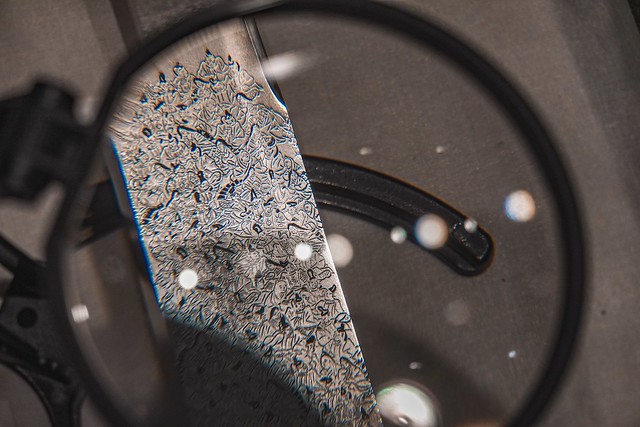
It is this delicate. Simply mind blowing.
And that concludes our 5D4N trip to central Japan on Toyota Rental Car with CEP (Central Nippon Expressway Pass)!
Toyama Airport

We drove back to Toyama Airport and return our car. Time to go back home.

Before you leave, you can actually have your meal at Toyama Sushi right at the airport.

For me I personally picked the Black Ramen as my farewell meal before heading back to Tokyo!
Once again, if you plan to self drive in central Japan, remember to rent a vehicle with CEP to allow you to travel more comfortably while saving cost.
You can find out more about the rates of the pass and rental car partners here:
https://hayatabi.c-nexco.co.jp/cep/en/
Have fun exploring central Japan!! ^^




